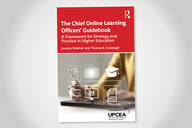You have /5 articles left.
Sign up for a free account or log in.
In April, Deloitte released a fascinating report titled "The World Remade by COVID-19." In the report, Deloitte develops different scenarios on the pandemic's impact over the next three to five years. As part of that scenario planning, the potential effects of COVID-19 are mapped against possible outcomes for various industries.
Higher education is not one of the industries considered in Deloitte's COVID-19 scenario planning. Those industries run A (aerospace) to T (transportation) but skip right over E (education).
This report and the lack of inclusion of colleges and universities have me wondering about where our industry might fit should Deloitte have chosen to include us.
The report builds its three- to five-year COVID-19 scenarios on five fundamental uncertainties: 1) The overall severity of the pandemic and pattern of disease progression. 2) The level of collaboration within and between countries. 3) The health-care system's response to the crisis. 4) The economic consequences of the crisis. 5) The level of social cohesion in response to the crisis.
Depending on how those factors play out, Deloitte envisions the following four scenarios:
- The Passing Storm: The pandemic is managed due to effective responses from governments to contain the virus but is not without lasting repercussions, which disproportionately affect small and medium-size businesses and lower- and middle-income individuals and communities.
- Good Company: Governments around the world struggle to handle the crisis alone, with large companies stepping up as a key part of the solution and an acceleration of trends toward "stakeholder capitalism."
- Sunrise in the East: China and other East Asian nations are more effective in managing the virus and take the reins as primary powers on the world stage.
- Lone Wolves: Prolonged pandemic period, spurring governments to adopt isolationist policies, shorten supply chains and increase surveillance.
It seems to me that higher education needs to move, at some point, from a total focus on the next few months to a longer three- to five-year time horizon. Across the postsecondary system, my sense is that the overwhelming majority of attentional bandwidth is being directed toward navigating the coming academic year. This focus on what is in front of us is entirely understandable, even defensible.
What Deloitte's scenario planning demonstrates, however, is that the pandemic's impact will be strongly felt beyond the coming months. In every scenario save one (The Passing Storm), COVID-19 continues to exert significant impact across every industry that is examined.
Ideally, postsecondary three- to five-year COVID-19 scenario planning would not be constrained to individual institutions. I'm not sure that individual colleges even have the people or time to devote to serious midrange scenario planning. Instead, this seems like an opportunity for schools in similar sectors (peer institutions) to collaborate on joint scenario planning.
Perhaps this is already happening? Do you know of higher ed professional associations, foundations or consultancies that are gathering peer institutions together to guide them through three- to five-year COVID-19 scenario building?
If three- to five-year COVID-19 scenario creation is going to occur in higher ed, then who should be participating in these exercises? The pandemic impacts every part of the university, from teaching and learning to student life to housing to athletics to libraries. It is impossible to separate the financial aspects of COVID-19 from the impact of the virus on faculty, students, and staff.
Should a three- to five-year horizon on COVID-19 scenario planning be narrow (say, focusing on teaching and learning) or broad (economic resiliency or the student experience)?
The scenarios developed by Deloitte don't map very easily onto our postsecondary landscape. We would need to develop higher ed specific scenarios.
The Deloitte report at least provides one model (there are many) to help us think about three- to five-year COVID-19 scenario planning for higher education.
Can you point us to some other models?
Are there existing postsecondary three- to five-year COVID-19 scenarios that have already been fleshed out?




